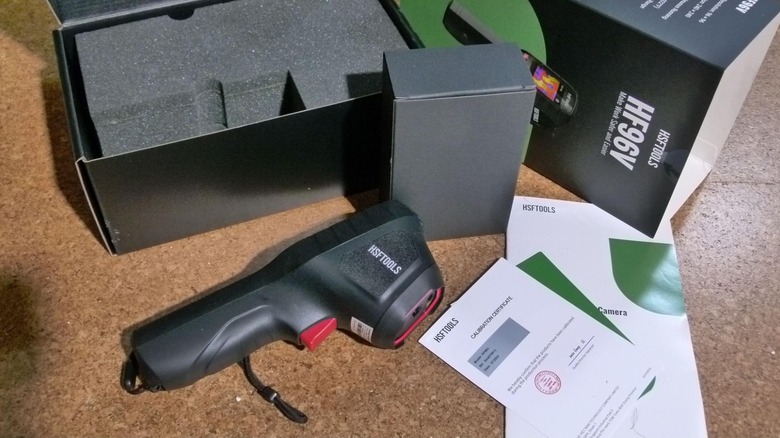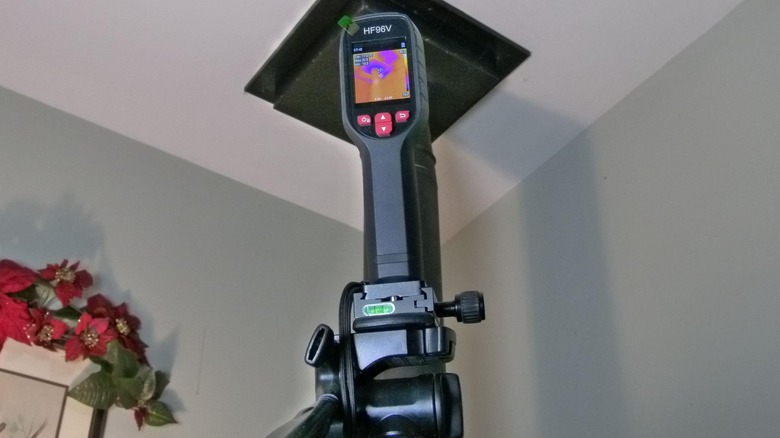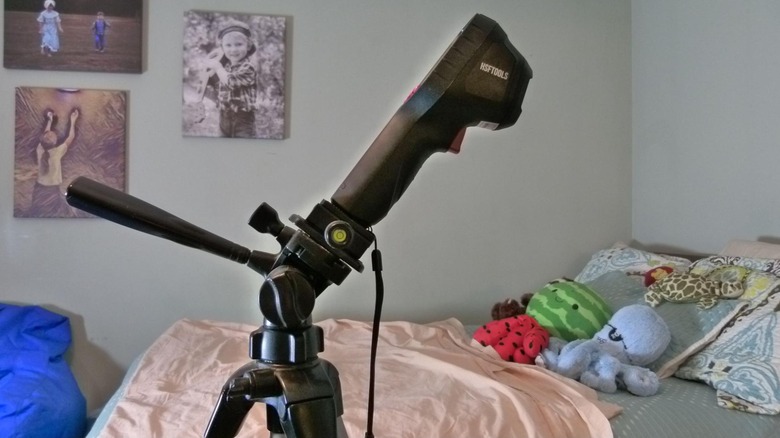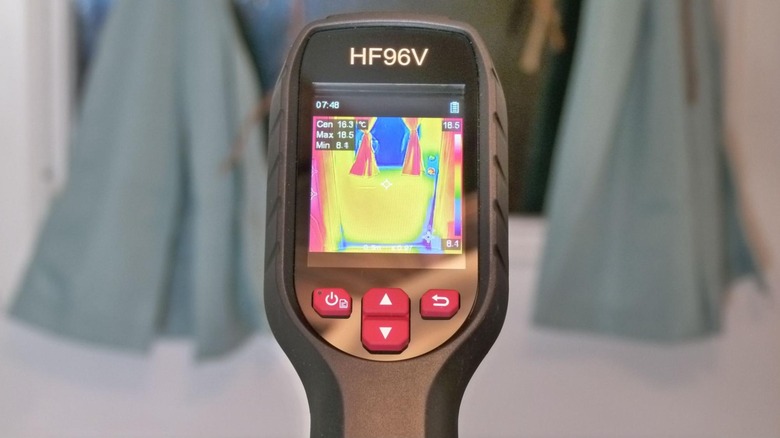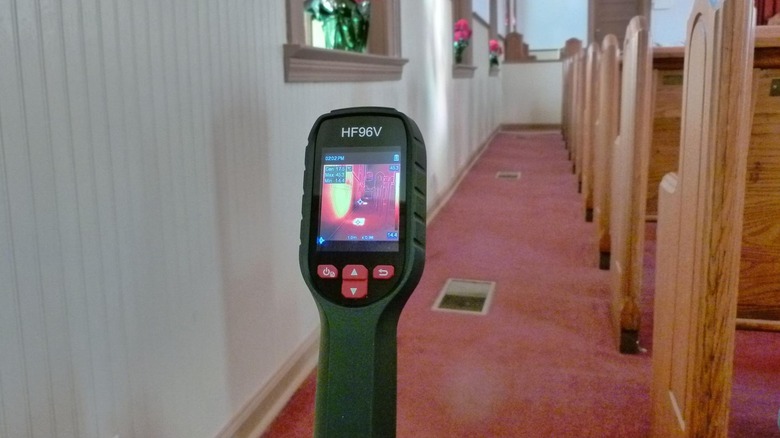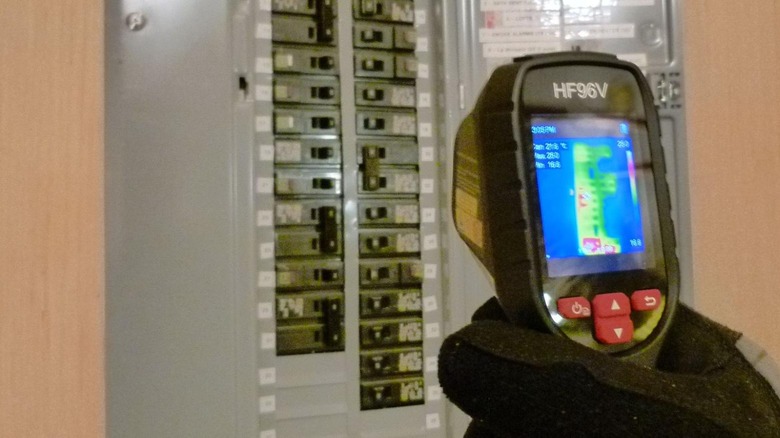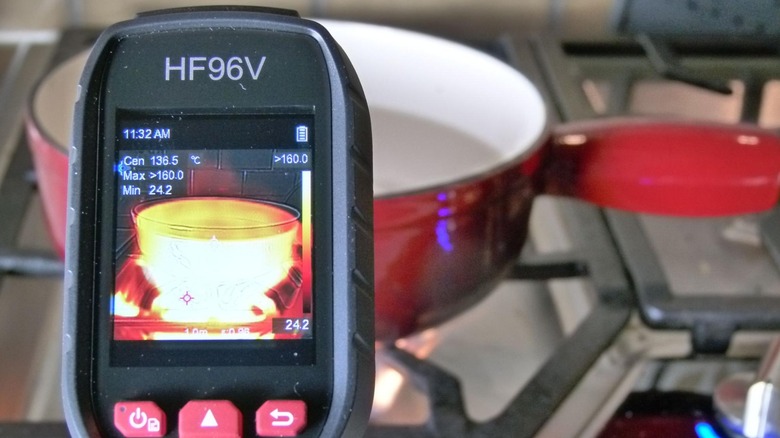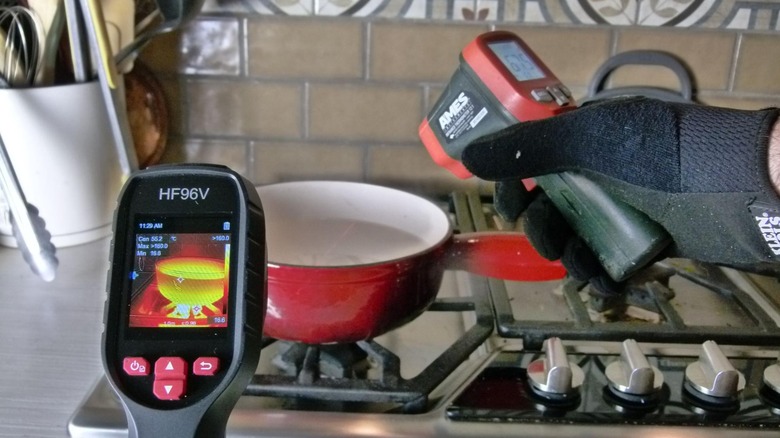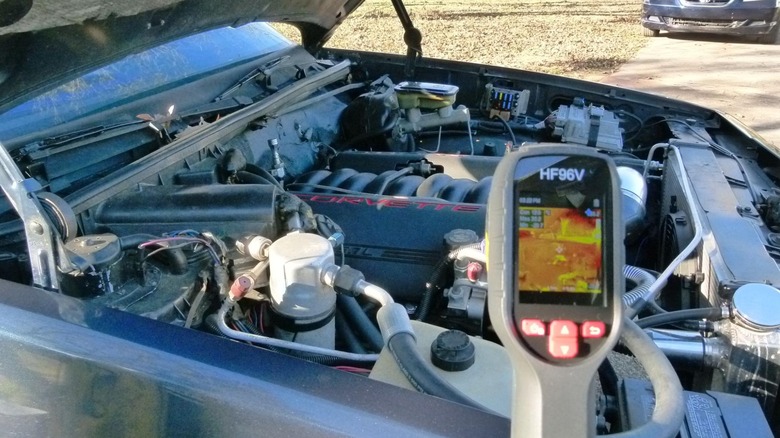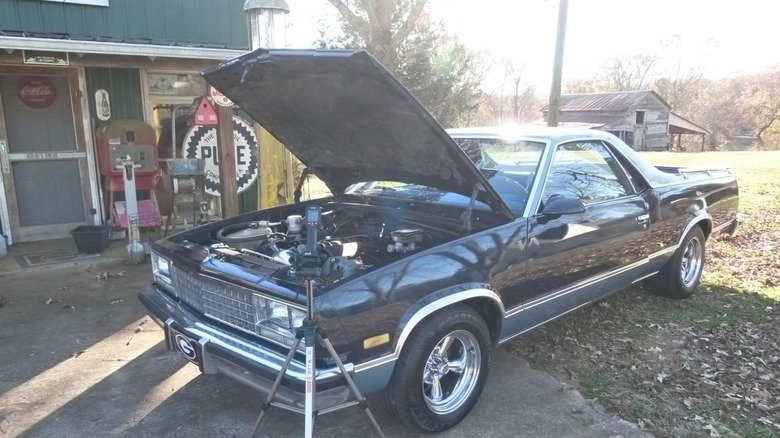The HF96V Thermal Camera Is More Of A Superpower Than A Tool
Sponsored Content. We may receive a commission on purchases made from links.
To the extent I've thought much about thermal cameras, I've mostly pigeonholed them as a sort of niche equipment for a handful of pros, no more useful to me than a surveyor's transit In the past few years, though, a series of personal projects and requests from family and friends to help diagnose issues around their homes has opened my eyes to the potential these strange little devices have. Strange because they view the world differently from me like a silicon-based alien lifeform, seeing light I can't perceive and representing it in the garish colors you'd expect from a sentient calculator or an interstellar mercenary.
When I started digging into the HSFTOOLS HF96V thermal camera, though, all the oddity and confusion began to fall away, leaving me with the distinct impression that I couldn't (or, at least, shouldn't) live without this thing in my tool arsenal. My next sentence would usually be something starting with "it's not for everyone," but in this case, I think it very nearly is exactly that. That is, in principle a thermal camera is potentially useful to almost anyone, and in particular the HF96V might be the specific camera most people should consider first. It's a portable, well-thought-out, well-appointed device endowed with the ability to save you from cut-rate builders, rushed contractors, the ineluctable corrosion of time, and even yourself.
This thermal imaging camera's specs are impressive
The list of capabilities of this camera is long enough that it's easy for one's eyes to glaze over poring over it all. The things that are extraordinary about it include the inclusion of both infrared and visual sensors, thermal sensitivity rated at < 50mK (capable of detecting 0.05℃ temperature differences), a measurement accuracy of +/- 2%, and the 8-hour battery life produced by its 3000mAh rechargeable battery. It captures IR images at a completely usable 96x96 pixels, then scales them up to 240x240 using an algorithm that enhances the most potentially useful parts of each image. It detects temperatures from -68 to 1022 degrees (in some places the range is cited as -4 to 1022), which is visualized in-camera using one of seven thermal palettes you can freely switch among. xtagstartz/p>
Why you might need a consumer thermal camera
Aside from their Finder S1, which is essentially an Android device accessory, the HF96V and its infrared-only little brother, the HF96, are the most basic models offered by HSFTOOLS. This is remarkable in itself, because these are very capable devices, uncluttered by most of the functionality homeowners simply don't need in a thermal camera. There are, of course, professional and industrial thermal imaging solutions available at far higher prices, with features like cryocooling, weatherproof enclosures, and extravagantly high resolution, none of which are useful for a homeowner.
Thermal inspections are often used to find second-order effects (like using surface temperature to find water leaks), and a visual inspection is in order when anything out of the ordinary turns up. Consider the example (which I'll clarify a bit more in the next section) of ductwork that admits cold air into a room. If a good look shows the ducts are well-insulated, living in the home reveals that areas around vents aren't drafty, and power bills are low, there's probably not much reason to deal with the "problem" at all. In this case, having bought a more expensive camera would only have the effect of further committing you to overestimating the problem and further reducing your ability to pay for any fixes, since you'd still be making payments on a $5,000 – or potentially $25,000 – pro or industrial camera.
The HF96V versus insulation problems
To get a sense of the HF96V's usefulness in diagnosing insulation issues, I threw it a curveball... a house I was pretty sure didn't have any insulation issues. On a near-freezing day, the camera turned up very few troubling cold spots inside the house, but the issues it did find were subtle and instructive. For example, the lower half of the home's back door was admitting a fair amount of cold air where the weatherstripping was worn – a cheap and easy fix.
A few less obvious problems were visible on the camera, though. One was a consistent cold band around the top of every exterior wall where the wall's drywall intersects with the ceiling's drywall. This is not uncommon. It's the result of thermal bridging where the wall framing intersects with the ceiling framing. (The best solutions to this are things like continuous exterior insulation, which is not even in the same zip code as cost-effectiveness for such a minor issue. In a warm home, you'd probably want to just pretend you didn't see it.) I also noticed that the heating vents would get very warm when the heat was running, then fall off rapidly to a much lower temperature when the thermostat kicks the heat off. This is the result of ducts running through an unheated crawlspace, and while the ductwork is insulated, it's obviously not insulated quite well enough to eliminate this effect.
The HF96V versus leaks
If a thermal camera is accurate, it will find unexpected water inside of walls, ceilings, etc. Still, it's helpful to know what to look for, experience is always useful, and I was having fun, so I went in search of a leaky building. I found one in the form of a nearby 130-year-old church that, in spite of having recently acquired a new roof, is reportedly still experiencing major leaks when it rains. Of course, there was no rain in sight for my area, but leaks have other sources (water supply or drain lines, for example), so I took a look anyway.
Without the rain, I struck out in the usual spots, like ceilings and under windows. Under the windows in the sanctuary I only found the infrared signature of the heating vents blowing on the wall. But it was valuable to know that a building of that age, with correspondingly aged plumbing in some areas, I didn't find any sign of a water leak. I'll be looking at everything again after the next big rain, in whatever year that happens.
The HF96V versus electrical and other issues
Fire hazards are probably the biggest safety concern when it comes to home wiring (there's a reason the National Electrical Code is issued by the National Fire Protection Association), and that risk can often be spotted early with a thermal camera. Loose electrical connections, wiring that's over-packed into conduit or electrical boxes, cables embedded in insulation, and multiple wires run through a hole that's too small can all cause heat buildup that rapidly turns into catastrophe. An electric arc might start a fire in seconds, but an issue that causes fire via heat buildup can sometimes take years to develop, and you can find those problems all along the way with thermal imaging.
I used the camera to peek at a few circuit breaker panels, including my own, and found a few breakers in mine that are significantly hotter than the others. Looking at the loads on those circuits, it appears that they are consistently loaded to near their ampacity, so I'll probably shift some things around to see if I can cool things down. In addition to insulation, water leak, and electrical sleuthing, you can also use a thermal camera like the HF96V for HVAC maintenance, cooking temperature control, automotive maintenance, and a number of other useful (and often critical) inspections. I poked around under the hood of a vintage El Camino and a somewhat less vintage Honda Odyssey. Both cars are running well, and what I mostly discovered was how roomy the El Camino's engine compartment is even after a Corvette engine swap, while there wasn't enough room left in the Odyssey for a copy of The Odyssey. But nothing out of spec, temperature-wise.
Using the thermal imaging camera's output
The HF96V can take photos in both thermal and (black and white) visual modes at the same time. These are stored on the camera and can be accessed by connecting the device to a computer, where it functions as a USB drive. In theory, you should be able to retrieve full-resolution (640x480) visual images, low-res (96x96) thermal images, and enhanced thermal images (240x240) from the camera, but I was never able to capture a thermal image in less than the 240x240 "super resolution." My plan was to take images in both resolutions, scale up the lower-res image using various interpolation methods, then compare my results with the camera's interpolation algorithm. The way the manual and other materials describe the HF96V's 6X resampling, it's tempting to think of it as similar to optical zoom on a standard digital camera... you'll get higher resolution, but usually lower quality. While I couldn't make the direct comparison I intended to, this does not seem to be the case with the HF96V's interpolation algorithm. The 240x240 images are reasonably sharp, and edges are well-defined.
When connected to a Windows computer, the HF96V gives you a choice of connecting as either a USB drive or as a UVC camera (basically a USB webcam). I tried UVC mode with a laptop and a desktop Windows PC, using Microsoft's Camera app, OBS Studio, and VLC, but never managed to get an image feed from the camera. Attempts to record in the Camera app turned out unusable files with a zero size. I didn't really have a need or a plan for this functionality, so I didn't pursue a solution for long.
Accuracy, whether you need it or not: testing the HF96V
Most homeowners will use a thermal camera to look for anomalies rather than zeroing in on specific temperatures, but sometimes accuracy is critical (determining if an electrical hotspot is an immediate danger, for example). Everyone has at their disposal two tools for checking the accuracy of a thermometer or thermal camera: boiling water and melting ice. So I set out to take pictures of hot and cold water. Where I live, at my altitude and barometric pressure, the boiling point of water is 210.94°F (99.41°C). The melting point of ice, which varies a little with barometric pressure, is basically unchanged from the seal-level norm at 31.6°F (-0.2°C). I also have a cheap infrared laser thermometer to compare the HF96V's readings to, and while its margin of error is far higher than the HF96V's, it would at least tell me if one of the devices is completely out of whack. I also tested the camera against a water kettle with digital temperature controls.
In all cases, the HF96V read within a degree or so of the expected temperature. The boiling water temperature readings would occasionally top 100 °C even with the emissivity properly set for water, but those readings were momentary, and well within the margin of error. I did learn that, when measuring boiling water, be careful not to steam up the IR lens. Infrared radiation will not penetrate the surface of water, and if that water is on the camera lens you'll eventually get readings that appear to show water boiling at room temperature.
Pros and cons of the HF96V
Aside from the trouble exporting low-resolution images and the difficulty using the camera as a UVC webcam, the only problems I had with the HF96V were a couple of minor usability issues. If you press the buttons on the device too hard and in the wrong spot, your on-screen cursor might occasionally fail to move. Once you figure out that you should use a lighter touch, this problem evaporates. The Super Resolution export bug, which will probably get addressed by a firmware update eventually, is even less of a problem, since the upsampled images are more useful than the low-res versions. And, while it would have been nice to stream via UVC to a laptop while walking around, that's more of a pro feature and a nice-to-have rather than a necessity for homeowners. I assume that problem will also get addressed in firmware eventually. I also experienced a little lag now and then, especially when moving the camera fast or from one scene to a very different one. This was very close to inconsequential.
On the other hand, the upsides of the HF96V are meaningful. The camera's specs show its thermal sensitivity as less than 50 mK, which FLIR (maker of high-end professional thermal cameras) rates as "great," its second-highest classification. The inclusion of a visual sensor, the variety of thermal palettes for display, the 8-hour battery life, inclusion of the laser pointer, and high measurement accuracy all point to an extraordinary consumer device at this price. In fact, MoviTHERM, seller of professional and industrial thermal cameras, says that "the expected accuracy of [thermal] cameras is no better than ±2° Celsius" – exactly the HF98V's accuracy level.
Looking at the big picture
It's impossible not to love this little device. My entire family wanted to walk it around the house like a new pet, showing it every little nook, cranny, and thermal break in our walls. Everyone's favorite was touching things, then watching the heat picked up from your hand dissipate from the touched object. (You can also follow a barefoot person through a house by infrared footprints.) But I imagine any decent consumer-level thermal camera would fulfill most of these urges. If you're prepared to spend the $239.99 (that's MSRP; it's currently available from Amazon for $219.99), you're probably expecting a bit more than a parlor trick.
I put the HF96V through its paces pretty thoroughly, and I'm hard-pressed to imagine the average homeowner having needs this camera wouldn't meet. And the upsides are huge. Any single problem you turn up is likely to save you far more than the cost of this camera, and your only real alternative is a professional thermal imaging inspection, which costs an average of $350 and might run you as much as $650. This little camera costs about a third of that, does all the same work, and you can use it periodically, or whenever you have suspicions about a leak, wiring problem, or other issue it can help you identify. I'm kind of surprised that mortgage lenders don't require homeowners to have them, and I'm a little ashamed of myself for never bothering to get one. Fortunately, at this quality and price, it's easy enough to put that shame behind you.
